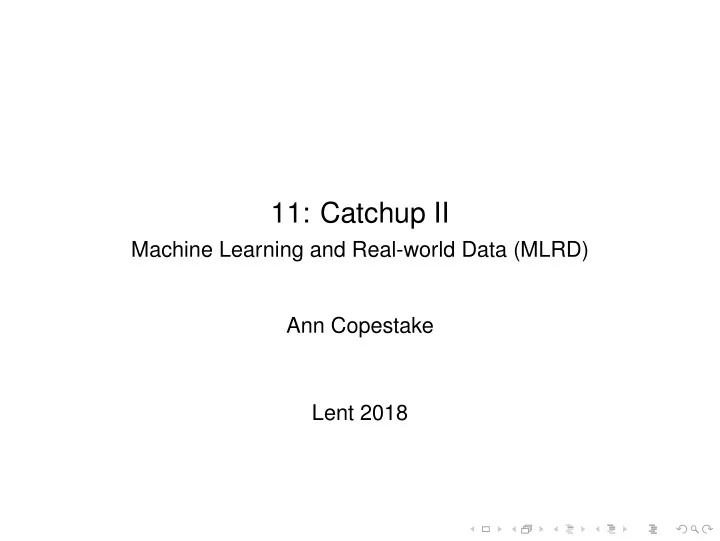

11: Catchup II Machine Learning and Real-world Data (MLRD) Ann Copestake Lent 2018
Last session: HMM in a biological application In the last session, we used an HMM as a way of approximating some aspects of protein structure. Today: catchup session 2. Very brief sketch of protein structure determination: including gamification and Monte Carlo methods . Related ideas are used in many very different machine learning applications . . .
What happens in catchup sessions? Lecture and demonstrated session scheduled as in normal session. Lecture material is non-examinable. Time for you to catch-up in demonstrated sessions or attempt some starred ticks. Demonstrators help as usual.
Protein structure Levels of structure: Primary structure: sequence of amino acid residues. Secondary structure: highly regular substructures, especially α -helix, β -sheet. Tertiary structure: full 3-D structure. In the cell: an amino acid sequence (as encoded by DNA) is produced and folds itself into a protein. Secondary and tertiary structure crucial for protein to operate correctly. Some diseases thought to be caused by problems in protein folding.
Alpha helix Dcrjsr - Own work, CC BY 3.0, https://commons.wikimedia.org/w/index.php?curid=9131613
Bovine rhodopsin By Andrei Lomize - Own work, CC BY-SA 3.0, https://commons.wikimedia.org/w/index.php?curid=34114850
7-bladed propeller fold http://beautifulproteins.blogspot.co.uk/
Peptide self-assembly mimic scaffold: an engineered protein http://beautifulproteins.blogspot.co.uk/
Protein folding Anfinsen’s hypothesis: the structure a protein forms in nature is the global minimum of the free energy and is determined by the animo acid sequence. Levinthal’s paradox: protein folding takes milliseconds — not enough time to explore the space and find the global minimum. Therefore kinetic function must be important.
Protein structure determination and prediction Primary structure may be determined directly or from DNA sequencing: relatively easy. Secondary and tertiary structure can be determined by x-ray crystallography and other direct methods, but difficult, expensive, time-consuming. Given amino acid sequence, can we predict the structure? i.e., determine how the protein will fold. Secondary structure prediction is relatively tractable: various prediction methods, including HMMs (cf last session). Tertiary structure prediction is very difficult.
Protein tertiary structure prediction Modelling protein structure fully is hugely computationally expensive. Ideally, should model all the water molecules too . . . Several approaches, including: 1 Molecular Dynamics (MD): modelling chemistry. folding@home: use home computers to run simulations. 2 Foldit: get lots of humans to work on the problem (an example of gamification ). 3 Use Monte Carlo methods (repeated random sampling) to explore possibilities.
Foldit: combined human-computer intelligence
Monte Carlo methods in protein structure prediction Objective: find lowest energy state of protein. Idea: start with secondary structure, try (pseudo)random move, see if result is lower energy and repeat. Problem: local minima — locally good move may not be part of best solution. So: also sometimes accept a move that increases energy. Specific approach Metropolis-Hastings : a type of Markov Chain Monte Carlo method.
Monte Carlo methods in general Using random sampling to solve intractable numerical problems. Earliest example: Buffon’s needle for estimating π By McZusatz - Own work, CC BY-SA 3.0, https://commons.wikimedia.org/w/index.php?curid=26236866
Monte Carlo methods Physicists developed modern Monte Carlo methods at Los Alamos: programmed into ENIAC by von Neumann. Bayesian statistical inference not until 1993 (Gordon et al): essential for many modern machine learning approaches. Gibbs sampling is a special case of Metropolis-Hastings. More about this in later courses: Mathematical Methods, Machine Learning and Bayesian Inference, Bioinformatics. Practical introduction by Geyer in http://www.mcmchandbook.net/HandbookTableofContents.html
Recommend
More recommend